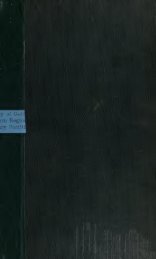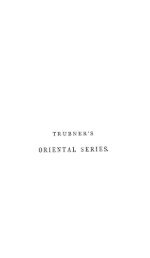Untitled
Untitled
Untitled
You also want an ePaper? Increase the reach of your titles
YUMPU automatically turns print PDFs into web optimized ePapers that Google loves.
. .<br />
NOTE XXVI. FEVERS<br />
I H3 ,<br />
putridity is the cause, while the hurt thereof is through the intervention<br />
of that heat which is produced from it. Arid the natural functions,<br />
wherein the hurt of fr)ver becomes apparent, are such as the appetke for,<br />
food and wine, digestion, rising up, sitting down, going, eating, sexual<br />
intercourse, and the like thereof."<br />
, j ><br />
The next (second) chapter, deals with the different kinds of fever,<br />
and is too long (3 pages) to be translated in Tull here. The human Body<br />
'.is Compounded of three sorts of substances; (i) basic tissues such as<br />
the bones, nerves and blood-vessels; (2) the marrow of the bones, the<br />
blood, and other liquids contained in the<br />
vessels and cavities of the<br />
body, such as the phlegm, bile and black bile, known as the 'humours';<br />
(3) the natural, animal or vital, and psychic spirits, and the vapours<br />
diffused throughout the body.' This composite body the ancients have<br />
likened to a hot bath, whereof the walls, bricks and stones are represented<br />
by the bones, nerves and bloocVvessels the water ; by the marrow, the<br />
blood, aad the humours and the steam ; by the natural, animal and<br />
psychic spirits, and the vapours. When the heat of the fever attacks the<br />
basic tissues of the it body, is like the heat of the finj affecting the walls,<br />
jtones and bricks of the hot bath ; and this kind of fever is called<br />
'<br />
hectic '<br />
(diqq). When it first attacks the humours and subsequently the<br />
basic tissues, it is like the hotjwater being let into the chambers of the<br />
bath and heating the walls and this kind of fever is called 'humoristic'<br />
;<br />
(khaltiyya). When it attacks the spirit and the vapours, which in turn<br />
heat the humours and the tissues, it is like the hot air in the bath heating<br />
in turn the water and the walls thereof and this kind of fever is called<br />
;<br />
1<br />
Arab, hummd yawm"'\<br />
'quotidian' (Pers. tab-i-yak-ruza ;<br />
This is one classification. Another is into '<br />
simple '<br />
(basft) and<br />
'<br />
compound '<br />
(murakkab\ according as one humour only is involved, or<br />
more than one. Thirteen kinds of fever are recognized, viz. :<br />
(1) That which is in itself an independent disease.<br />
(2) That which is the symptom of some other disease.<br />
(3) Very high<br />
(4)<br />
'<br />
fever called acute '<br />
(hddda).<br />
'<br />
The slower and heavier fever called chronic '<br />
>(5) That which attacks by day.<br />
(6j That which attacks by night.<br />
(7) That which passes 'away easily.<br />
(muzmina).<br />
(8) 'Fevers which are fierce in their onset and accompanied by<br />
alarming symptoms.<br />
(9) Continjous'fevers (Idzim or mutbiqa).<br />
(10) Non-continuous fevers (muftira).<br />
(n) old fevers.<br />
(12) Fevers accompanied by rigors (Pers. larza; Arab, ndfid, ra'da).<br />
(13.) Fevers accompanied by 'goose-skin' (Pers. fardshd; Arab.<br />
qash'artra).<br />
T,hese, says the author, are the broad general divisions,' each of<br />
which contains subdivisions which will be treated of in subsequent<br />
chapters. Fevers of the type called " putrid " l<br />
( q/!n, in Persian ganda or<br />
'








![La religione di Zarathustra nella storia religiosa dell' Iran [microform]..](https://img.yumpu.com/15970820/1/151x260/la-religione-di-zarathustra-nella-storia-religiosa-dell-iran-microform.jpg?quality=85)


